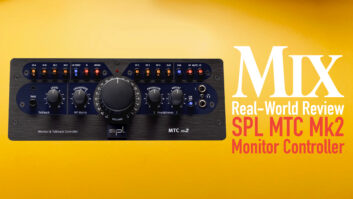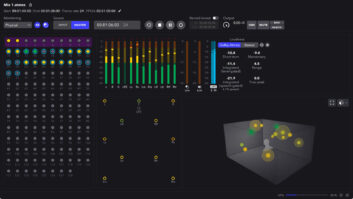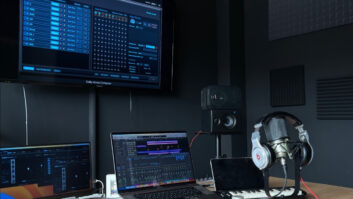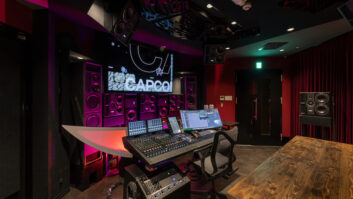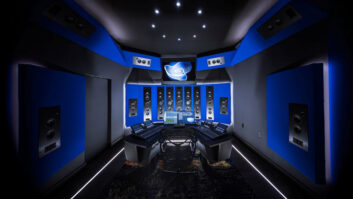A new product based on “innovative microphone technology” all too
often turns out to be just a low cost knock-off of a classic studio condenser. For that reason alone, we should all
take notice when something truly different and special comes along.
Different and special, the Atmos 5.1/ASM 5 Surround Recording System
certainly is. Much more than just a microphone, the Atmos system pairs
a specialized rackmount 5.1 recording console from SPL with Dirk
Brauner’s ASM 5 Adjustable Surround Microphone.
Both SPL and Brauner are German manufacturers, and both are known
for high-tech, high-performance products. SPL has found success in the
analog, tube and digital domains with devices such as Vitalizer,
Transient Designer, Loudness Maximizer, Machine Head and Charisma.
Brauner is established as a top-end microphone maker and is responsible
for the VM1, considered by many as one of the best studio mics in
production today. The ASM 5 uses five VM1 capsules in an array designed
for surround recording. Though the Atmos 5.1 console and ASM 5 mic
array are available separately, the combination of the two creates a
powerful, yet easy-to-use package.
THE ATMOS 5.1 CONSOLE
Housed in a five-rackspace chassis (with an outboard 1U power supply),
the Atmos 5.1 is essentially a 5-channel mixing console with five XLR mic inputs, plus a large multipin input
connector for the ASM 5 microphone array’s 12-pair cable. It should be
noted that though the Atmos is designed for use with the ASM 5, the
user is free to use any combination of other mics with the system.
However, the ASM 5 provides excellent performance right out of the box,
with minimal experimentation.
The Atmos 5.1 front panel features backlit mechanical VU meters and
gain controls for the five mic inputs (left/center/right/surround
left/surround right). Input channels may be fed from either the ASM 5
or the five discrete mic inputs, and each channel has switches for mic
pad, polarity reverse, +48 VDC phantom power, insert in/out, a choice of 50Hz or
100Hz highpass filters. Bus switches route each signal
to the center, L/R, Surround Left/Surround Right or direct output
buses. Each channel also has a rotary fader and controls for
determining divergence and Front/Surround and LCR positioning. A pair
of stereo aux inputs—with their own peak LEDs and level
pot—can be routed directly to the L/R, SL/SR and center buses.
The Atmos 5.1’s rear panel has balanced XLR and unbalanced 11/44-inch
connectors for the five channels (direct outputs), monitor and master
outputs and insert point send/returns on every input.
A slick feature puts the (servo motor-controlled) trim pots of all
five channels under a single control. This mode, which is engaged via a
small pushbutton near channel five’s gain switch, comes in handy when
the band plays at a softer level during soundcheck, but cranks it up
during the actual take. Precise level matching is essential for
maintaining a coherent soundstage when multimiking for 5.1, and the
motorized fader control is a real plus.
Spread controls for the front and surround channels allow users to
tweak the stereo soundstage of the fronts and/or surrounds and also
dial in the distance separating the front and surround mics.
Thoughtfully, both spread sections include mono and bypass switches for
making quick A/B comparisons or checking for any possible compatibility
issues when either the fronts or surrounds are summed to mono. Two
9-LED phase meters indicate the relative correlation between the L/R
and SL/SR channels, and six 20-segment LED meters show 5.1 output
levels.
The monitor section has a large, ganged volume control that
simultaneously drops the level of all six (5.1) channels evenly.
Speaking of outputs, the Atmos 5.1 includes balanced analog outputs for
the six outputs—control room (varied by the monitor pot), as well
as the main outs, which may be routed to the multichannel storage
medium of your choice. Besides the six discrete monitor outputs, a
stereo headphone jack and a 6-pin DIN connector for Sennheiser’s
Surrounder headphones are provided. One of the Atmos 5.1’s most
distinctive features is a set of five pots that remotely determine the
polar pattern of each of the VM1 capsules; all are continuously
variable from figure-8 to cardioid to omni, and anything in between. Also,
it should be emphasized that the system’s discrete outputs are designed
to route directly to a recorder/workstation, etc. No surround encoders
are included so the user can select whatever is necessary
(AC3/SDDS/DTS/etc.) or nothing at all, depending on the job at
hand.
Interestingly, the ASM5 mic system has no dedicated sub-bass mic
element. Any LFE or subwoofer information is derived from the L/R bus,
the SL/SR or center channel bus. Here, a 130Hz lowpass filter can be
switched in-line with the rear panel XLR sub output.
IN THE STUDIO
As noted above, the ASM5 offers remote pattern selection for each mic
element. The large, pentagonal array also allows each capsule to
physically swivel 180ø (ñ90ø) along a horizontal axis,
allowing for an almost inexhaustible number of array variations. The
ASM5’s LCR (front) mic heads are placed in a triangle with each capsule
17.5 cm from the center. They can be electronically “moved” using the
Front Spread and Divergence controls on the Atmos. The further two
SL/SR capsules are about 60 cm to the rear with a 60ø adjustment
range. The custom multipin snake cable that attaches the ASM5 array to
the Atmos 5.1 mixer is 25 meters long, and longer cables can be
ordered.
Having used these VM1 capsules before (albeit connected via tube
electronics in the Brauner VM1), I was anxious to hear how they’d
perform in a multimiking application via discrete solid-state
electronics. I was not disappointed. Obviously, SPL made a major issue
of performance when designing the Atmos 5.1 system. The mic preamps are
triple gain-stage, low-noise designs with Lundahl input transformers,
illuminated switches and relays with gold-plated contacts. The preamps
are an excellent match for the mic capsules. Noise was nonexistent, and
even under highly dynamic conditions, such as when miking a four-piece
percussion group, the Atmos 5.1 was up to the task, offering ample
headroom and tight transient response, while preserving low-level
detail in quiet passages. One thing that intrigued me during this
session was the system’s ability to capture extremely diverse frequency
ranges and delivering thunderous low end—despite the fact that
there is no dedicated LFE mic element—while capturing all the
upper harmonics of the crotales and stacked bells.
Before using the system, I expected that placement would be
critical. However, I found that using the system is fairly instinctual
and even fun, especially with all the variable parameters (continuous
polar patterns, arm placement adjustments and capsule rotation on the
mics, while experimenting with the spread, pan and divergence controls
at the console).
In later sessions, I used the Atmos system to mike an acoustic
guitar/mandolin ensemble and a standard, five-piece, rock ‘n’ roll drum
kit. I became even more comfortable with the system, and in both cases
was rewarded with a natural sound. The mic array is consistent at
different distances, and there really is no magic “sweet spot” to be
concerned with. Certainly, the imaging becomes more “in-your-face” (or
perhaps more accurately “in-your-ears”) when the array is placed
directly over the source and becomes less pronounced as the front of
the array is drawn back to a distance from the source. In cases where a
tight overhead placement is employed, the aux inputs on the Atmos 5.1
can come in handy to add a pair of preamped stereo ambience mics to
pick up additional room character. Yet, at any configuration during
these dates, I was impressed by the lack of phase anomalies—there
were no frequency roll-off or pattern dropouts when the 5.1 tracks
were collapsed to stereo.
The SPL Atmos 5.1/ASM 5 is an extraordinarily powerful tool for the
creative recordist. Priced at $27,990, it’s definitely a significant
investment, but one that could be promoted as a major hook for drawing
certain clients into a commercial studio. And to encourage users to try
Atmos out, distributor Group One also offers the system on a rental
basis.
SPL, www.spl-usa.com
